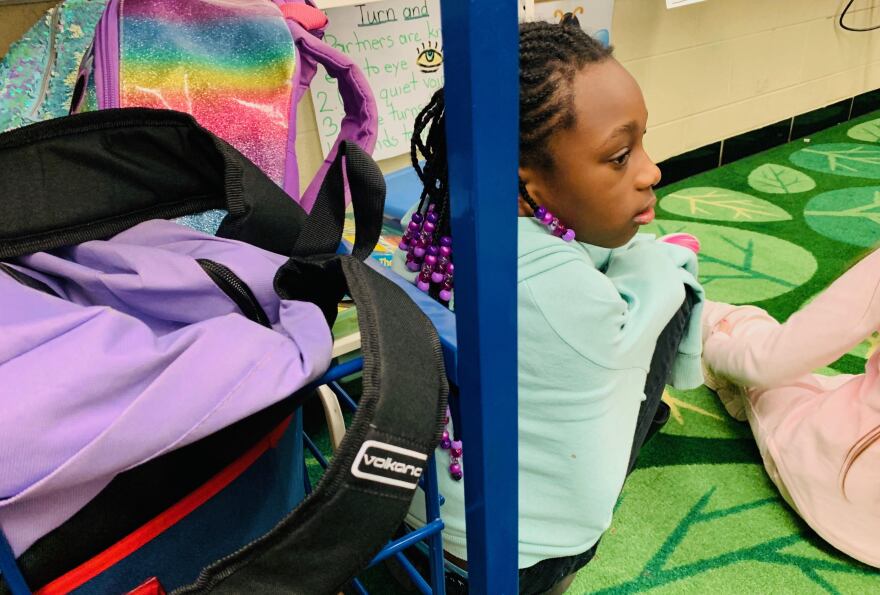It’s a quiet winter morning at Neithercut Elementary in Flint, and the kids in Theresa Skene’s kindergarten class are munching contentedly on their school breakfasts: milk, Froot Loops, strawberry yogurt, some kind of strudel stick wrapped in plastic. Mindfulness music (as Mrs. Skene calls it) plays softly in the room, as she stops at one boy’s desk to praise him for cleaning up a spill.
But before breakfast is over, a little boy enters the room, thrashing and shouting, his mom trying to restrain him. “No I’m NOT!” he yells. His mom stands behind him, wrapping her arms around his. “Stop,” she says firmly. “NO!” he yells again, throwing his head back to strike her chest and twisting his head to try to bite her arms.
All eating has stopped. The kids’ eyes are on Mrs. Skene.
“How about we do this,” she begins, unruffled, and suggests taking him to the room where the behavioral specialist works. “He’s still not going home yet,” Skene assures the mom.
“I AM!” the boy yells, shoving a desk.
“I’ll be right back, boys and girls,” Skene says, leading the way down the hall.
The kids lean in over their breakfast trays. “He always has such an attitude problem,” says one boy, his l’s coming out as w’s, so it sounds like “attitude pwobwem.”
“He’s sad,” says the girl sitting next to him. “He’s just having a bad day. Sometimes he just runs out the classroom.”
“He’s not bad,” a second boy insists. “He’s good! He’s really good.”
The first boy reads the room, and revises his earlier take. “Yeah, apparently he really likes his family,” he nods solemnly. “I didn’t realize that.”
Rising rate of special needs post-water crisis
Five years ago, during the water crisis, the kids currently in Flint’s kindergarten and elementary classrooms were babies and toddlers, the population most vulnerable to lead exposure. Some may have spent their infancy drinking formula mixed with lead-tainted tap water, month after month.
Even low levels of childhood lead exposure have been linked to decreases in IQ. Elevated lead levels in the blood may raise the risk for ADHD and developmental delays. Numerous studies say it can also increase aggression and reduce impulse control, and according to the CDC, some researchers have found a “direct association between BLLs [blood lead levels] and poorer performance on tasks requiring focused attention, cognitive flexibility, and inhibition of automatic response.”
Flint’s superintendent, Derrick Lopez, says that’s what’s happening in these schools.
"We actually have the first set of kiddos that are coming to us at kindergarten this year, who were at the epicenter of the water crisis."
"We actually have the first set of kiddos that are coming to us at kindergarten this year, who were actually at the epicenter of the water crisis,” Superintendent Derrick Lopez said this summer. “And we are looking to probably increase [special needs] ... because of the challenges the kids have faced with the water crisis.”
The water crisis began in April 2014. The following school year, 2014-2015, special education students made up about 15% of the district (the state average is around 13%.) By 2017-2018, that had risen to roughly 20%, according to the most recent available state data. And in August of this year, Superintendent Lopez said they were approaching 28%.
“And so I think that, coupled with the financial stress of that, is really the biggest challenge we’re facing here in Flint right now,” he said.
Another challenge: the drastic decline in enrollment. Fifteen years ago, more than 20,000 students attended Flint City School District. Last year, it was just over 4,000.

And an additional 10,000 students live in the district, but choose to go somewhere else for school, either through school of choice, charter schools, or other options. (More than 5,000 students living in Flint attend charter schools, but just 13% of them have disabilities, according to state data. Some Flint teachers say they think charter schools aren’t accepting kids with special needs, which they believe just compounds the problem for the school district.)
Regardless of where these students go, or why, their per-pupil state funding leaves the district with them, making it that much harder for the district to respond to the increase in special needs.
A changing classroom
None of this comes as a surprise to Jo-K Boegner. With some 20 years of experience in the district, she’s now teaching first and second graders at Neithercut Elementary.
“The behavior issues, they’re way up,” she says. “We never dealt with these behaviors…. [Previously] you might have one, two explosive kids in a couple years span. Now it’s widespread.”
So Boegner says she’s had to adapt. “They don’t have their short term memory,” she says. “So you’ll teach a math concept, and the next day, they don't recall. So you have to constantly re-teach, re-teach, re-teach.”
Lead exposure isn’t the only challenge. Jacqueline Kildee also teaches first and second grade in Flint, and from her desk at the front of her room, she quietly indicates which of her students is in foster care, who’s homeless and living with a rotation of friends and family, and one child whose brother is in the hospital after intervening in a fight between his parents.
"It's hard to watch,” Kildee says. “They need more than I can give.”
If there were some kind of teacher training for working with lead-exposed kids, she’d take it, she says. “But then I think, it's never happened before. Does anyone know what the best way to work with these children is? Because I don’t know what it is."
Like Boegner, she's developed strategies in the classroom. She keeps her kids moving and interacting, focused on a tangible goal. When they’re working on a new vocab word, Kildee has them write and draw examples of the word in a sentence. “They just love doing it because I’ll staple it together and it’ll make a little book. It’s the Frayer Model, and they know what a Frayer Model is now. Something about that, they love.”
Still, the challenges her students face both inside the classroom and out of it, mean that teaching comes second right now. The first priority is classroom management.
Kildee points out one boy in her classroom who was well known for behavior problems last year. He threw desks and “ripped the building apart,” she says. This year, he just didn’t show up to school for the first month. When he finally did, both she and Boegner sat him down. “We said, 'Listen, it’s not happening this year.’ We do not have a classroom like that.”
"He has not had a tantrum like that. He hasn't thrown anything. He's matured a lot. And he gets a lot of hugs. Like one time, he was being naughty and pinching, and he just had this look on his face. And I called him up, and he laid his head on my shoulder and just sobbed. Just shaking."
That boy’s been making real progress, Kildee says. “And I think because the classroom was already set up and running smoothly, he would have stuck out like a sore thumb.He has not had a tantrum like that. He hasn’t thrown anything. He’s matured a lot. And he gets a lot of hugs. Like one time, two or three weeks ago, he was being naughty and pinching, and he just had this look on his face. And I called him up, and he laid his head on my shoulder and just sobbed. Just shaking.”
But sometimes, the problems boil over
Ask these teachers what they need, and their answers are the same: more help. More hands in the classroom. More social workers and special ed teachers, and someone to finally take over for the long-term substitutes. The staffing shortage is critical.

Bridget Davidek teaches third grade, and says this year’s class is one of the best she’s ever had. They’re smart and ask questions that even stump her, she says. But she still needs to squeeze as much learning as possible into the morning, when her students are calmer, more focused.
She hates the end of the day. The last hour before dismissal is always the hardest. One afternoon, as kids put on their coats and bus arrivals are announced over the loudspeaker, three fights break out in Davidek’s class, one right after the other.
Two of them are minor scuffles, quickly broken up. But one boy loses control and puts his hands around a girl’s throat, choking her. Chaos erupts. Davidek is yelling. “ALL OF YOU SIT DOWN, NOW! HEADS DOWN! NOW!” J’ade, the girl who was choked, is crying.
The next day, in the cafeteria, J’ade is eating school lunch (turkey, gravy, and mashed potatoes) with her friends. Bright and attentive, she walks through the fight the day before. “He put his hands on my neck, like that, and slammed me on the desk,” J’ade says. “I felt scared, and nervous.”
After the fight, the school's principal talked with J'ade and the boy who hurt her (we’re not using his name to protect his privacy.) But you watch him in class, and it’s like the kindergarteners said about their classmate: he’s not a bad kid. He loves Legos. He has a baby face, and it lights up when someone’s kind to him. That day, after lunch, he stopped a fight between two other kids.
But when the staff here are already stretched so thin, they can’t catch every blow up before it gets out of hand. And they can’t give the students who have the biggest challenges all the help and attention they need.
So sometimes, those kids get sent home.
Special ed students disproportionately suspended, expelled
The year after the water crisis, the rate of special needs kids being expelled or suspended increased by more than 1,600%. State officials have repeatedly cited the district for disproportionately disciplining special education students. In May, the state found Flint schools "noncompliant" and demanded a “corrective action plan."
“They can't just suspend them,” says Greg Little, an attorney with the Education Law Center. “They can’t expel them. That's not taking care of the problem. That's avoiding the problem. And that's what's taking place right now.”
Little is part of a team of attorneys, including the ACLU of Michigan, suing both the school district and the state on behalf of Flint special education students.
They believe the state bears the real responsibility for its role in creating the water crisis. “The bottom line is the state ended up poisoning these kids,” Little says. “Then they abandoned them. And now they're not providing them with the resources that the school needs to survive.”
There is hope, experts say. Childhood lead exposure can be mitigated, but early intervention is critical. Nutrition is key, and early childhood education is highly encouraged. Researchers also urge parents and teachers to keep monitoring and evaluating kids' development, and use those findings to help students take advantage of federal programs for disadvantaged or disabled kids.
So far, Little and his team have reached a partial settlement with the state: funding to open the Neurodevelopmental Center for Excellence in Flint, where kids can be screened for special needs. But just identifying those children isn’t enough, Little says. The district still needs more specialists and staff, and better solutions than just suspending or expelling troubled kids.
“And if they don't receive the care and services that they need as soon as possible, it only gets worse and worse and worse,” he says.
This lawsuit is scheduled to go to trial this spring. But by then, another school year will be almost over. And these students who were so young during the water crisis will still be waiting for the help they need.







